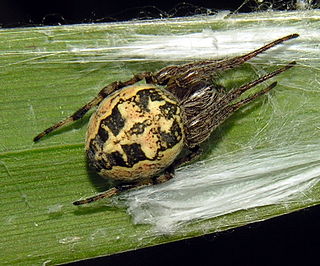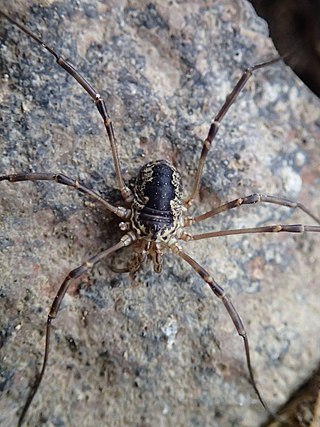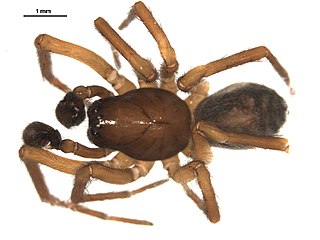
The northern shrike is a large songbird species in the shrike family (Laniidae) native to North America and Siberia. Long considered a subspecies of the great grey shrike, it was classified as a distinct species in 2017. Six subspecies are recognised.

The Mygalomorphae, or mygalomorphs, are an infraorder of spiders, and comprise one of three major groups of living spiders with over 3,000 species, found on all continents except Antarctica. Many members are known as trapdoor spiders due to their creation of trapdoors over their burrows. Other prominent groups include Australian funnel web spiders and tarantulas, with the latter accounting for around one third of all mygalomorphs.

The Pholcidae are a family of araneomorph spiders. The family contains more than 1,800 individual species of pholcids, including those commonly known as cellar spider, daddy long-legs spider, carpenter spider, daddy long-legger, vibrating spider, gyrating spider, long daddy, skull spider, and angel spider. The family, first described by Carl Ludwig Koch in 1850, is divided into 94 genera.

The red-cockaded woodpecker is a woodpecker endemic to the southeastern United States. It is a threatened species under the Endangered Species Act of 1973.

The Goliath birdeater belongs to the tarantula family Theraphosidae. Found in northern South America, it is the largest spider in the world by mass and body length, and second to the giant huntsman spider by leg span. It is also called the Goliath tarantula or Goliath bird-eating spider; the practice of calling theraphosids "bird-eating" derives from an early 18th-century copper engraving by Maria Sibylla Merian that shows one eating a hummingbird. Despite the spider's name, it rarely preys on birds.

Larinioides is a genus of orb-weaver spiders commonly known as flying spiders and first described by Lodovico di Caporiacco in 1934. They mostly occur in temperate climates around the northern hemisphere. The name is derived from the related araneid spider genus Larinia, with the meaning "like Larinia".

Larinia is a genus of orb-weaver spiders first described by Eugène Simon in 1874.
Mahembea is a genus of African orb-weaver spiders containing the single species, Mahembea hewitti. It was first created by M. Grasshoff in 1970 to separate this species from its original genus, Larinia. It has only been found in Central and East Africa.

Steatoda borealis is a species of cobweb spider in the family Theridiidae. It is found in the United States and Canada.

Leptobunus borealis is a species of harvestman in the family Phalangiidae. It is found in Europe and Northern Asia and North America.
Ips borealis is a species of typical bark beetle in the family Curculionidae. It is found in North America.
Aphoebantus borealis is a species of bee flies in the family Bombyliidae.

Melanoplus borealis, known generally as the northern spur-throat grasshopper or northern grasshopper, is a species of spur-throated grasshopper in the family Acrididae. It is found in North America.
Cardiastethus borealis is a species of minute pirate bug in the family Anthocoridae. It is mostly found in North America.
Ogcodes borealis is a species of small-headed flies. Hosts include spiders of the genus Pardosa as well as the species Schizocosa rovneri.

Amaurobius borealis is a species of hacklemesh weaver in the spider family Amaurobiidae. It is found in the United States and Canada.
Phrurotimpus borealis is a species of true spider in the family Phrurolithidae. It is found in North America.

Cantuaria borealis is a native New Zealand species of trapdoor spider.

Larinia jeskovi is a species of the family of orb weaver spiders and a part of the genus Larinia. It is distributed throughout the Americas, Africa, Australia, Europe, and Asia and commonly found in wet climes such as marshes, bogs, and rainforests. Larinia jeskovi have yellow bodies with stripes and range from 5.13 to 8.70 millimeters in body length. They build their webs on plants with a small height above small bodies of waters or wetlands. After sunset and before sunrise are the typical times they hunt and build their web. Males usually occupy a female's web instead of making their own. The mating behavior is noteworthy as male spiders often mutilate external female genitalia to reduce sperm competition while female spiders resort to sexual cannibalism to counter such mechanisms. The males also follow an elaborate courtship ritual to attract the female. The bite of Larinia jeskovi is not known to be of harm to humans.












